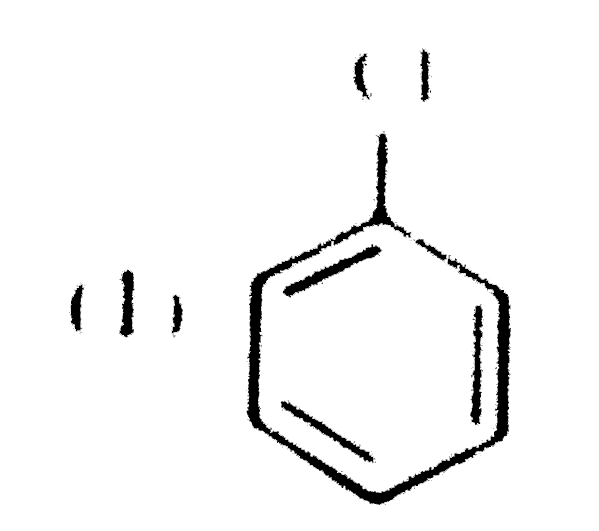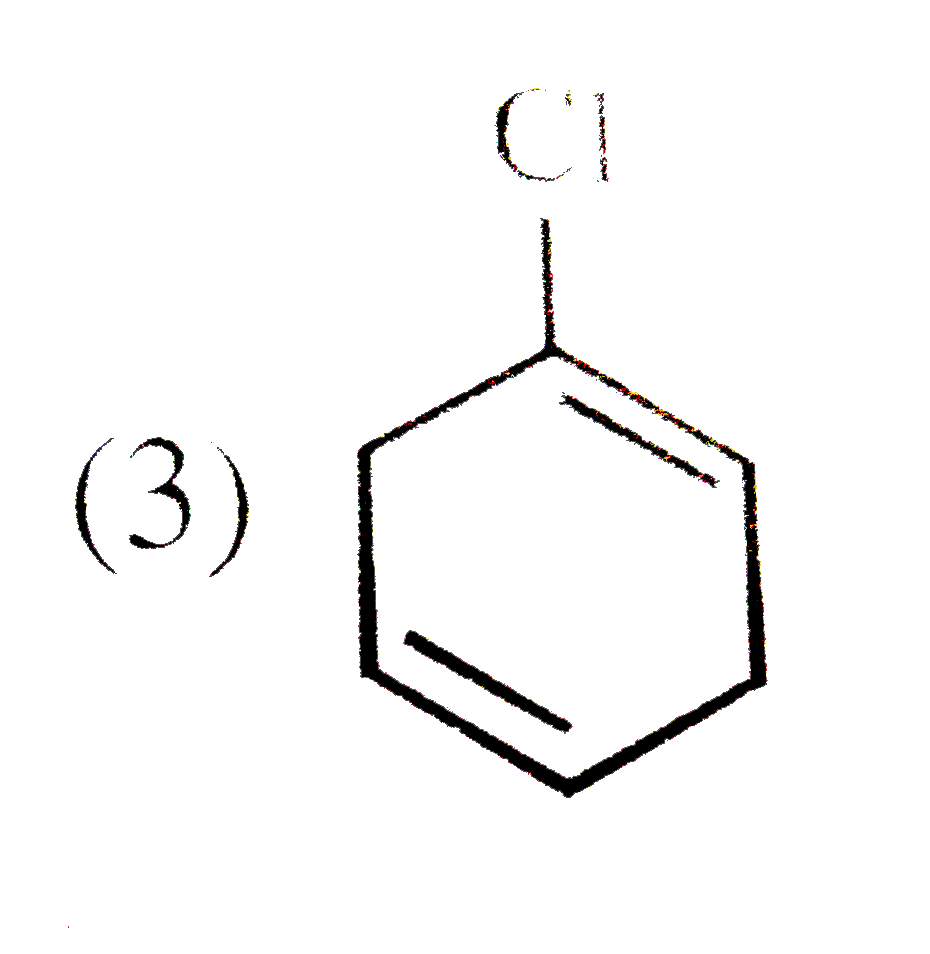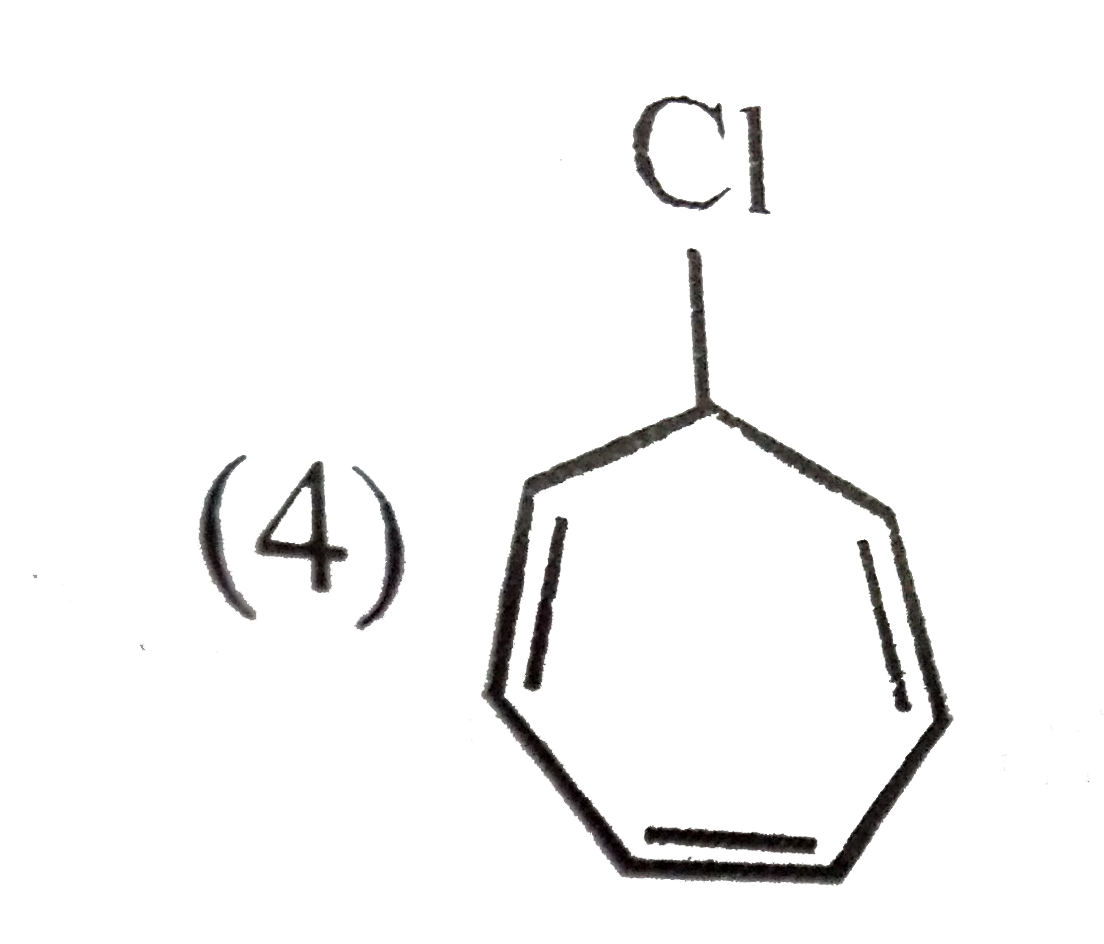Which of the following compound will give curdy precipiate with AgNO3 solution:




The correct Answer is:D
To determine which compound will give a curdy precipitate with AgNO₃ solution, we need to identify which of the given compounds can release chloride ions (Cl⁻) when reacted with silver nitrate (AgNO₃). The formation of a curdy precipitate indicates the formation of silver chloride (AgCl), which is a white precipitate.
1. Understanding the Reaction:
- Silver nitrate (AgNO₃) reacts with chloride ions (Cl⁻) to form silver chloride (AgCl), which is a curdy precipitate.
- The reaction can be represented as:
AgNO3+Cl−→AgCl↓+NO−3
2. Analyzing the Options:
- We need to assess each compound to see if it can release a chloride ion when reacted with AgNO₃.
3. Option 1: Chlorobenzene (C₆H₅Cl):
- Chlorobenzene has a chlorine atom attached to a benzene ring. The chlorine is part of a stable aromatic system and is not easily removed.
- Conclusion: Chlorobenzene will not give a curdy precipitate.
4. Option 2: Vinyl Chloride (CH₂=CHCl):
- Vinyl chloride can potentially release a chloride ion, but upon losing Cl⁻, it forms a carbocation (CH₂=CH⁺), which is unstable.
- Conclusion: Vinyl chloride will not give a curdy precipitate.
5. Option 3: Cyclohexene with Chlorine (C₆H₈Cl):
- This compound can also release a chloride ion, but the resulting structure after losing Cl⁻ will have a positive charge on a double bond, which is also unstable.
- Conclusion: This compound will not give a curdy precipitate.
6. Option 4: A Seven-Membered Ring with Chlorine:
- This compound can release a chloride ion, and upon doing so, it forms a stable aromatic compound.
- Conclusion: This compound will give a curdy precipitate with AgNO₃.
Final Answer:
The compound that will give a curdy precipitate with AgNO₃ solution is Option 4 (the seven-membered ring with chlorine).
- Silver nitrate (AgNO₃) reacts with chloride ions (Cl⁻) to form silver chloride (AgCl), which is a curdy precipitate.
- The reaction can be represented as:
AgNO3+Cl−→AgCl↓+NO−3
- We need to assess each compound to see if it can release a chloride ion when reacted with AgNO₃.
- Chlorobenzene has a chlorine atom attached to a benzene ring. The chlorine is part of a stable aromatic system and is not easily removed.
- Conclusion: Chlorobenzene will not give a curdy precipitate.
- Vinyl chloride can potentially release a chloride ion, but upon losing Cl⁻, it forms a carbocation (CH₂=CH⁺), which is unstable.
- Conclusion: Vinyl chloride will not give a curdy precipitate.
- This compound can also release a chloride ion, but the resulting structure after losing Cl⁻ will have a positive charge on a double bond, which is also unstable.
- Conclusion: This compound will not give a curdy precipitate.
- This compound can release a chloride ion, and upon doing so, it forms a stable aromatic compound.
- Conclusion: This compound will give a curdy precipitate with AgNO₃.
The compound that will give a curdy precipitate with AgNO₃ solution is Option 4 (the seven-membered ring with chlorine).
Topper's Solved these Questions
Similar Questions
Knowledge Check
Which of the following compounds will react with NaHCO3 solution to give sodium salt and carbon dioxide?
AAcetic acidBn-HexanolCPhenolDboth (b) and (c).Which of the following compounds will react with NaHCO3 solution to give sodium salt and carbon dioxide?
AAcetic acidBn-HexanolCPhenolDboth (b) and (c).
Which of the following compounds will form the precipitate with aq.AgNO3 solution most readily?
View SolutionWhich one of the following is likely to give a precipitate with AgNO3 solution ?
View SolutionWhich one of the following is likely to give a precipitate with AgNO3 solution ?
View SolutionWhich of the following does not give yellow precipitate with AgNO3 ?
View SolutionWhich of the following does not give a precipitate with alcoholic AgNO3 ?
View SolutionWhich of the following compound will given yellow precipitate on shaking with aqueous solution of NaOH followed by the addition of AgNO3 solution ?
View Solution